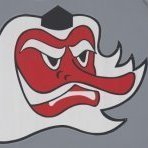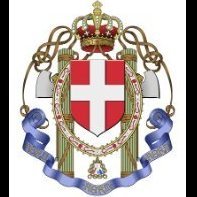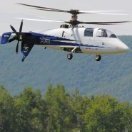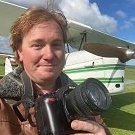Leaderboard
Popular Content
Showing content with the highest reputation on 02/24/2022 in all areas
-

RA-5C Vigilante - scratchprinted
sandokan and 14 others reacted to Starfighter for a topic
I'm glad you guys like it! She's growing...15 points -

RA-5C Vigilante - scratchprinted
sandokan and 10 others reacted to Starfighter for a topic
I have spent quite some time adding more surface detail and preparing the main gear wells. The fuselage surface detail is pretty much finished, so I went ahead and mirrored the LH side fuselage halves in order to get a full fuselage. I will now add the non-symmetrical surface detail to each half before I can print them. Basic detail added to the main landing gear wells: No need to put too much effort into the forward portion of the bay as it'll be hidden by the closed lower gear door anyway. Like the big forward landing gear door (which was even locked with the landing gear in locked position), they were pretty much always closed on the ground. Isn't she a beauty? The full depth intake trunks are visible from this perspective as well.11 points -
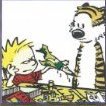
EA-6B Prowler (02 April: Done!)
johncrow and 8 others reacted to easixpedro for a topic
Dug into some old photo albums and found these. Thought I'd share, And some good tail chase shots as we messed around at the boat. Flying at sea is unlike any other flying, in that its pretty much uncontrolled airspace. You launch with a full bag of gas and get an hour plus of flight time to rage around with your hair on fire. Depending on the flight, you might not even talk on the radio, just show back up overhead Mom at the appropriate time to land. Pure unadulterated freedom. The reason I was digging for pics, is cause I was looking for this picture. Did some messing around with printing decals last night. Not 100%...want to give it another go to really recreate that old-school metal stencil look. Putting your name on a model is probably seen as arrogant by some. Probably is, but I don't care and its pretty dang cool to have made it this far! Onward and upward! -Peter9 points -
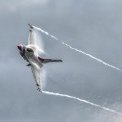
Jetmads has Announced an F-22A Raptor in 1/32 Scale
KiwiZac and 7 others reacted to Stokey Pete for a topic
Anybody know how to make convincing looking vapour streams? I took this shot at RIAT a few years back.8 points -
>>>> Before installing the stores, a few photos were made of a “clean model” as the Gripen is often seen flying. The canopy was temporarily positioned on the cockpit closed for making photos. After the photos were made, the stores were set in place with super glue, everytime just a tiny glue dot is needed. This took an afternoon to set all stores aligned and symmetrical. Note that there are still tiny gaps seen on the real Gripen at the pylons and thus also on the model. Stores set are the IRIS-T wing tip missiles, central tank (improved earlier), the designator pod and the 4 sets with bombs. That’s it after a 4 month and a 150 hours effort! This old 1/32 Revell Gripen “after waiting for 30 years in the loft” has turned out to be a “BLUE BOX OF HAPPINESS” after all! Meindert Photos of the 1/32 Gripen in the “clean configuration”: .. with canopy closed... ... cockpit canopy open.... … and with the stores installed… SAAF Gripen JAS39C tail code “12” / 3912 of no. 2 squadron based at Makhado AFB , South Africa8 points
-
8 points
-
Jetmads has Announced an F-22A Raptor in 1/32 Scale
KiwiZac and 7 others reacted to DavidJMason for a topic
Finally!!! I pitched the 1/32 Raptor to Trumpeter, Hong Kong Models, Kittyhawk, and Tamiya. They all said NO. Too big. Too risky. Only the USA has them. Won't sell internationally. It's not sexy enough. It's not combat proven. Etc, etc, etc. Of course it's only the best air-to-air fighter in existence right now (2022). I contacted them and offered to help. I hope they get it right.8 points -
Wolfpack Phantom - 8th TFW F-4C
Rockie Yarwood and 5 others reacted to John1 for a topic
Thanks very much Tom. Still plugging away, my focus now is on the pilot's cockpit. Plenty of pictures out there, with the exception of the aft bulkhead area. Many of the ones I've found are from semi-derelict jets, which aren't fully representative of the real deal. That being said, they have given me enough info to get started. Nothing exotic for the bits I've added, just plastic sheet and copper and lead wire. I just got a delivery of various diameters of lead wire and this stuff is great. I've never used it before but it's much superior to copper and/or styrene rod. Extremely pliable and easy to work with. Note - I won't be adding much to the upper bulkhead at this point. I'll need to have the cockpit installed in the fuselage and then I can go back and add those details. Got a lot more details I need to pack into this area. So my standard caveat - Still much to add to both 'pits but I'm getting there! The hydraulic (assume that's what it is) reservoir isn't really working for me. I'm thinking I'll do this part over. It all looks a bit crude in these closeups but I'm confident that when done and viewed from a normal distance, this will improve. You guys gotta trust me on this one!6 points -
.. final steps to complete the model…. The kit nose wheel strut parts can be used as well. Again, to my surprise. Detailing was done with wire and sprue. Setting the strut in the nose bay was checked with the real Gripen wheel base of 5,20 m for the single seater Gripen which is 16,2 cm in 1/32. Inside the repositioned bay, smaller bits were added to have the extra detail. The nose gear bay was painted white. The resin Armory nose wheels were set and the pair of new long nose doors of 56 mm made from card. Again hydraulics and wires were set using “JMC lead wire” that can be bended and twisted easily. The front gear door was set and the large hole in it should correspond with the location of the strut light that was also made. On all 3 landing gear struts, hydraulic lines using “JMC lead wire” were added that can be bended and twisted easily. DECALLING AND SCHEME Decalling was now done before installing other bits as the model is easier to handle. But first the model got several gloss varnish layers using my favourite Johnson Future thinned with IsoPropylAlkohol (IPA). The home designer decals were now set at the model. SAAF Gripen JAS39C tail code “12” cn 39-2103 coded 3912 of no. 2 squadron based at Makhado AFB near the town of Louis Trichardt in the North of South Africa was picked. Photos were studied obviously were the decals should go. Each decal had to be separated from the printed sheet and with gloss varnish set on the model to avoid tiny air bubbles (“silvering”). Decalling took a whole day. Studying photos was needed to determine what decals are needed. The new style “roundels” were added on the wing and fuselage but none are present on the lower surfaces. I had printed quite some in different greys and only 4 were needed. Note that the roundel Eagle head looks inside and forward, so these are not symmetrical. On the SAAF Gripens a few no step “feets” were added on the mid fuselage and intakes. A few hot air markings were also set and a few white warning panels. The lower fuselage appears to have hardly any markings. Above the intake anti-collision lights the SAAF Gripen code “3912” was set with numbers found in the decal spare box. PITOT On the Gripen I saw at the pitot a few small side flow vanes. Though the kit part has these, they have a slightly different shape so these were made from thin card and blended in with white glue and painted ghost grey. A few self made NO GRIP stencils were set on the nose pitot vanes. The pitot itself was replaced and was made from a thick metal needle. On the vertical tail, also a leading edge pitot was set made from a metal needle. FINAL COCKPIT WORK In the cockpit, the large HUD was set as per kit but with a few support rods. The prepared ejection seat was fixed in place after it got another few very tiny details. The canopy rear bar aft of the seat needed a slightly more rear position than I first thought and after it was detached it was repositioned. Some wiring was set along with an actuatormade from electrical wire. The canopy is detachable as I used very tiny metal wires to hold the canopy that correspond with holes in the sill/ edge. The canopy can be positioned open. VARIOUS LIGHTS, ANTENNAS AND OTHER BITS The landing lights was set on the gear struts were made from shiny bits of a hobby set. The white anti-collision lights on the rear fuselage next to the exhaust were made from clear plastic just like the tri-angular light above the rudder. The anti-collision lights on the intakes were set on the previously re-shaped fairings and painted a tiny bit of clear green and clear red with Tamiya clear paints. The large antenna on the spine was made with card as were the tinier antennas. Below the cockpit nose, an additional antenna was was and one below the rear fuselage. Small vanes were set made from metal bits on the cockpit sides and in front of the nose gear. On the missile wing tip rails, the black recesses were suggested with black paint. These will be mostly hidden when the IRIS-T missiles will be installed but a small portion can still be seen. EXHAUST The kit exhaust part can be used but it is moulded in the closed setting. I wanted an open exhaust and had found something earlier in the spares box that could be used. This part has the correct 30 mm diameter and is from probably the F404 engine found in the Academy F/A-18 kit. (in fact: the real Gripen RB12 engine is derived from the F404 engine I believe). I also found an afterburner flame holder to be set inside. A few slots were cut and with some twisting extra detail suggested. The exhaust was airbrushed in a few coats of ALCLAD burned metal. The insides were painted burned white with oil paint. (Note that I had prepared most of this work earlier). Now the exhaust was set in place with super glue. Any tiny reamining gaps filled with white glue but after drying this was not painted but suggests the exhaust to be perfectly set. CANARDS The pair of canards, that were previously improved, were set in place. They have a bit angle upwards and were set at slight rotated tilt. On parked Gripens, their orientation varies. STORES I wanted to add a few stores onto the Gripen. Some nice photos on the internet and in books showed that the SAAF Gripens can in theory carry a large variety of stores. It is unclear if these were all delivered due to high costs. I also saw IRIS-T air-to-air missiles though on the wing tip rails. These missiles were luckily found in the spares box coming from the 1/32 Revell Eurofighter kit. I had to shave off a few raised stubs on the missile part in order to get a fit without too large gaps with the rail. The missiles were airbrushed ghost grey FS36320 with a few painted stripes and metallic seeker head. I saw a few nice photos with SAAF Gripens flying with probably sort of mk.80 series bombs with short fuse. These are probably mk.82 “dumb training bombs”. The bombs were found in the 1/32 Trumpeter A-7 Corsair kit. Each bomb had a white body and the rear bomb section with fins is about FS34079 green. After that, a few stripes were added with decal and a shortened fuse head that was painted metal. From a few bits from the spares box, the needed bomb carrying Alkan twin store carriers were crafted. Some guessing was needed. They are about 48 mm long in 1/32. All was airbrushed. A Litening targeting pod was seen on SAAF Gripens as well below the starboard intake. I have seen on internet that though these pods are available, the smart bombs are not ?? I only saw dumb bombs when the pod was installed during training missions. Wel, anyway, a spare pod found in the spares box, left over from a 1/32 Tamiya F-15E kit. The pod was airbrushed dark gunship grey and a few stencils added with decals. A lower pylon for the pod was previously made from scrap of about 6 mm height and 60 mm long. LADDER As the canopy would be set open, it would be nice to use the entry ladder with the model as well. The kit parts proved to be quite good in shape so the kit parts were used. I only added an extra cross bar and that was it. The ladder got a yellow FS13538 coat (with Gunze Sangyo H329) and hand painted black sections. I did not want to fix the ladder, so from tiny metal rod a sort of hook was made to hung it in place. (strictly, this is not seen on the real ladder). It fits well with the correct proportions as very early the cockpit section of the fuselage had been lengthened and the windscreen was also corrected. FINAL COAT I always airbrush a final varnish coat on a model, in this case a semi-gloss coat. This to give the model an even sheen and to protect the decals. I airbrushed a mix of my favourite Johnson Future acrylic floor varnish thinned 20% with IsoPropylAlkohol (IPA) and some drops of Tamiya X-21 Flat Base, this will dull the varnish a bit giving a semi-gloss sheen. The stores were not forgotten and also got a coat and all was set aside to dry. >>> direct to next post >>>>5 points
-

Hrvatska kockica
Out2gtcha and 4 others reacted to blackbetty for a topic
why do i keep doing these things to me?5 points -
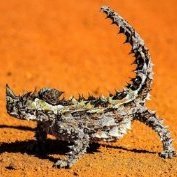
HK Models Lancaster Tweak List
Bomber Command nut and 3 others reacted to Uncarina for a topic
The HK Models Lancaster, first released in 2018, is a great kit: no serious shape issues, innovative engineering (eg, one piece wings), excellent fit, ease of assembly. It does have some tweaks however, that can make it even better. Various modelers besides myself have identified them (for example Jeroen Peters and Nigel from Large Scale Modelers and Iain (AKA Bomber Command Nut)), and I certainly take no credit for the entire list, but wanted to compile the most obvious ones here. Feel free to contribute to this list as you see fit. The majority of them are applicable to modeling most Lancasters, and some are for a specific version, noted as such. For photos I cite the page number from my Late War Canadian-built Lancaster Mk.10, “Sugars Blues” build: 1) Cockpit (Pages 1, 2, and 3) --Seat Pan is 4.5mm too long, 1.5mm too high, and the seat pan floor is raised 2.5mm too high --Armor plate is 3mm too short --Pedestal height should be raised 15 mm from the main floor --The red landing gear lever assembly is missing a rear cutout and the lever is overscale (Page 5) --The instrument panel support column is vertical and should be replaced with one that angles downward and forward a few degrees --Add rivets to the control column and remove the gap on the forward face --Add blackout curtains to the rear of the cockpit cutout on the left fuselage half (Page 17) --Add a moveable lamp to the Navigator's table 2) Bombardier Position (Page 4) --Add two vertical posts that connect the forward flight deck to the forward fuselage --The Williamson strike camera (part P26) is missing a cone that extends almost to the inner window face --The bombsight support frame is molded as a simple L-shaped piece and can be replaced with short lengths of rod --The forward escape hatch is missing a white "Parachute Exit" sign 3) Nacelles (Pages 10 and 11) --Add an opening to the two small intakes on either side of the lower nacelle which are molded solid --The main intake has a curved surface from below the propeller spinner all the way back to the radiator, when according to reference photos it transitioned to a flat shape to match the top of the radiator --The kit includes only the "Far East" late war version which was slightly larger with a larger intake. Seen from the front, this can be amended by using fine mesh screen and framing to match the standard intake (Page12, 18) --The tops of the wheel bays are too thick and can prevent a good fit of the inner nacelles to the wings (Page 17) —The small intakes on the upper side of the outer nacelles should be removed —The small intakes on the upper side of the inner nacelles are the wong shape, and the port inner nacelle should have the intake moved to its starboard side Note: If you want to build the nacelles without the engines the parts required are not listed in the instructions but are included in the kit: -- Attach the propeller shaft (Y15) to the nacelle front (K43) -- Attach the forward radiator face (Y4) to the lower cowling (H8). This will be the trickiest part to line up, but I'd suggest adding styrene spacers to help. --Attach the firewall (K11) to the rear nacelle halves (G11 and G12). This will be critical to help line up the cowling sections. 4) Wings (Page 10) --The landing lights were located under the port wing, but HK has them molded under both --They were concave lenses, but HK just has molded circles engraved --The life raft hatch was located on the top of the starboard wing, but HK has them molded on top of both --The wing outer sections may have a poor fit when attached to the main sections; 5) Landing Gear (Page 21) -- The rear main support struts which are meant to articulate along half of their length was molded as a solid block on the kit. --The kit has a support strut which is often seen in museum aircraft which helped support the landing gear but not seen in wartime photos 6) Fuselage (Page 14) Note: late war Lancasters had a cabin air vent above the starboard wing. The kit includes this (part M21) but does not include it in the instructions 7) Canopy (Pages 14, 21, and 23) —Some Lancasters had blisters on both sides of the canopy, some on only the starboard side, and some had none. The kit canopy does not include a cutout on either side, so this can be improved by carefully drilling the appropriate cutout. To do this trace the outline of one of the blisters on Tamiya tape, cut out the inside, then apply it to the canopy side as a template —The canopy is missing blackout curtains —The astrodome is a fully enlosed dome, not a partial shape as depicted in the kit Note: Some Lancasters had sections of the rear canopy framing only on the interior whereas others had them on the exterior as well. You can depict the interior framing by using internal masks, painting the inside frames black, then mask these sections when painting the exterior frames. (Pages 14 and 26) 8) Horizontal Stabilizers --The stabilizers have different detail between their upper and lower surfaces. Some early releases of the kit have you assemble two upper surfaces together and two lower surfaces together. This can pose a problem since the connecting pins will interfere with a other and one of the stabilizers will lack the rods which connects it to the fuselage. To correct this cut off the connecting pins and add two short rods that will fit in the matching holes in the fuselage. Later releases of the kit has this corrected. Well done HK Models! 9) Rear turret (Page 31) Note: some late war Lancasters had a section of the perspex missing from the rear turret to allow better visibility for the gunner. Carefully remove this section based on the aircraft you are depicting. Cheers, Tom4 points -
I hope I am wrong, but unfortunately it is to be feared that with the current events in Ukraine, the ICM team must have other concerns. The same goes for Roden or Miniart. Very sad Richard4 points
-
Make the others jealous
Model_Monkey and 3 others reacted to Artful69 for a topic
I haven't really had the time to relax and do a lot of build work ... mostly because I'm catching up with other, long overdue, chores or looking for my next job. I HAVE, however, had time to hunt around for some more gear to add to the collection ... As I am inclined to do, with the sort of purchases I make, I build up a few "rewards" points with a variety of local (meaning Australian) outlets ... and along with some sort of periodical sale late last year, it netted me this: Sometime late last year a couple of things happened at around the same time ... I saw the latest movie about The Battle Of Midway and Infinity model advised that it was going to be releasing 32 scale Val's and Kate's this year ... that definitely got the creative ideas flowing for Pacific war subjects ... so I snagged these around Christmas time from one of my main suppliers ... Apparently the Avenger will need some small modifying to turn it into the correct variant for Midway - have a really nice example of a build bookmarked for this purpose - though no build thread ... and the SBD will need some small decal adjustment for Best's kite ... Thach's Wildcat will happen curtesy of this kit which I had to go to a previously unused suppler for ... - eventually - as I ordered special decals from an AM supplier in the US ... which were promptly returned to the sender by USPS! Not all that happy with the moron either, who - 1/ instead of asking if I'd like the refund first (as opposed to waiting for restrictions to ease - and reattempting postage) - 2/ refunded me the amount - less fees which, along with the currency transfer, incurred me a loss ... and then 3/ blamed MY COUNTRY for HIS COUNTRY'S shipping restrictions!! (insert some VERY profane words here!!) *** IF anyone knows where I can get some 32 scale Decals (or masks) for Thach's markings OUTSIDE the USA ... please give me a heads up - TIA *** To "bulk out" the order for the free shipping ... I grabbed some Grenadier figures to use - because you can never have too many different poses At around the same time I used some more reward points to pre-purchase this monster ... The Das Werk 1/16 StuG ... Because the PzKpfwIII chassis is my favourite ... It just arrived at the post office yesterday ... It also gave a profile that I'll put to use for my TAKOM 35 scale StuG ... While I was looking around to source the new Great Wall Hobby P.40 ... I ended up reading a little about the Ki.43 Hayabusa ... Although completely different, it used the same philosophy in design and was commonly referred to as the "army Zero" ... looking around online for one proved to be a bit of a headache though, as it seems Hasegawa is rolling back production on 32 scale AC models. This prompted another splurge in buying ... Particularly Hasegawa Kits!! ... but also others ... This order, from a local supplier, arrived yesterday also ... I wanted the StuH.42 for the Kursk gear and also, maybe, I may have use for the Marder.I ... The Hasegawa George happened to be in stock along with a couple of sets of Master's phenomenal turned brass ... There is another order from a local supplier that is stuck in the traffic jam due to train line damage that recent el-weirdo weather conditions caused. So that one will be posted here once it arrives ... Meanwhile I got busy internationally ... Ordering kits out of Japan or Hong Kong (from local manufacturers in the region) is usually much cheaper that buying them here ... there's a catch though (isn't there always??) ... Shipping is prohibitively expensive IF you are only buying the one kit! If you are buying in bulk, however ... shipping is a boon! ... the shipping cost per item decreases exponentially ... most times ... Apparently Japan has followed the USA's example of "banning" certain countries ... although there ARE workarounds with certain global couriers. I've got a couple of orders still inbound from Hong Kong along with the delayed package ex-east coast ... but this one arrived from Plaza Japan today ... With a little "thank you" note and gift ... And a few Hasegawa Kits ... Along with this re-release of an old kit that fascinated me when I first saw it a couple of years back ... Thats all for now ... more to post later Rog4 points -
Point taken - and that is a really cool angle However....4 points
-
4 points
-
Hello, thank you for your compliments! I know that during the exercise in Norway in the 1990 the RAF GR.5s operated with only external fuel tanks and few times with a pair CBLS. But I want to represent my GR.5 with some of the stores used by the RAF attack jets of that time, imaging the Harrier back at Wittering AF base a few days after the exercise. So, a couple of MATRA rocket pods, a Phimat chaff launcher, a couple of BL755 CBUs in drill form, and to finish a pair of AIM-9 drills. This external load represents the variety and type of armaments that a GR.5 could carry in those days and... add a bit of color to the model itself. CIAO! Piero4 points
-
Nice clear video. HTH. Cheers Matty3 points
-
Hi Rog, take a look here: https://www.dersockelshop.de/wolfpack-wd32004?number=WD32004 Even for reduced price at the moment. Regards, Nils3 points
-

Make the others jealous
Rick Griewski and 2 others reacted to LSP_K2 for a topic
A couple more books added to the ol' stash. Both used, but both in really good shape, and quite reasonably priced too.3 points -
Jetmads has Announced an F-22A Raptor in 1/32 Scale
O.W and 2 others reacted to adameliclem for a topic
F-22 announced on 2/22/2022. Well done.3 points -
Back onto printing parts again - as the ambient temperatures are slowly creeping up here in the UK! I'd taken several goes at thinking through how to do the wings - and a tailplane dropping on the floor at our November model Club meet (Wiltshire Scale Model Society) caused me to rethink earlier plans/thoughts. I *was* going to print the wings, in two main sections + tip, from the root to the tip - with the layer lines running from leading edge to the trailing edge - parallel to the aircraft centreline. However - the clean break along a layer line on one of the tailplane components caused me to re-think the strength side of things - and have the layer, or 'grain' running from root to tip, with the layers almost parallel with the sweepback on the main section of wing. A limitation here is the size of the print bed - which has meant a break into 3 main sections, plus the swept back tip. With a split along the wing, from root to tip I could print from an inner wing 'flat' section provided by this cut - and use it to sandwich a full-length spar between separate leading and trailing edges of wing. The trailing edges are really thick - and the trailing edge on the inner sections is slightly curved - when it should be straight. Decided easier to print without modification - and sand back from the outside to thin once the wing is assembled. This has a knock-on - the printed plastic needs to be solid at the trailing edge - rather than a hollow fill - so this has dictated a thicker wall on the wing parts - 1.9mm v. 0.8 on the fuselage. For strength I've also upped the fill density on the root sections to 25%, rather than the 20% for the rest of the wing/airframe. Gear bays will be cut out after the wings are finally shaped - have learned with FDM printing that it's sometimes better to not remove sections at the software stage and rely on supports as that can lead to a little distortion. Anyway, on to the photos, or it didn't happen, right? So - inner two-thirds of the Port wing - the outer section and swept back tip are on the printer as I type - in glorious Boeing Kermit Green: This is how they are orientated on the printer bed: Mid-wing sections: And a final one taped together - with engine pod. Why? Well, because I can, because it shows the size of these parts and, well, it encourages me to see progress! May be some more over the weekend, if I have a full Port wing to assemble... Wish me luck! Iain3 points
-

RA-5C Vigilante - scratchprinted
Pete Fleischmann and 2 others reacted to Starfighter for a topic
Cheers gentlemen! Dave, I use an Anycubic Photon Mono X which enables me to print pretty large parts in a good quality. The cockpit is nearing completion. I made a test print of the LH side side consoles and the inner sidewalls and testfitted them - doesn't look too bad. There is a lot more CAD work to do as well. The front and rear IPs are pretty much ready for a first test print: The area behind the pilot's seat is super busy but good photos are very hard to come by. I did my best to replicate the radarscope fairing and the viewfinder based on photos and the works drawings I have on hand. The only missing element is the canopy actuator. With all the wires added, it should looks busy enough - and most of it will be hidden below the canopy anyway.3 points -

Jetmads has Announced an F-22A Raptor in 1/32 Scale
RALPHY ROCHA and one other reacted to LSP_Kevin for a topic
Just saw this on Facebook: https://www.facebook.com/JETMADS2016/posts/999547414300877 Kev2 points -
https://me109.info/display.php?a=e&l=en&fid=11242 https://me109.info/display.php?a=e&l=en&fid=13705 https://me109.info/display.php?a=e&l=en&fid=10687 https://me109.info/display.php?a=e&l=en&fid=381 https://me109.info/display.php?a=e&l=en&fid=605 Maybe this will support your choice. Looking forward to your build. Regards, Nils2 points
-
Legend!!! Thanks Nils!! Rog2 points
-
All true........... However, the Spitfire is one of the most graceful aircraft to ever take to the skies, but even she doesn't look like a dancing queen on the ground with her gear down. Its all about perspective. That being said, an in flight display with an F-22 would be REALLY nice looking.2 points
-
Good show. Nice, nice, and very nice. Sincerely, Mark2 points
-
The cockpit equipment continues. After the belts it is time for the clocks. I have got not only the company kit but also the EDUARD plate and YAHU Models kit. I have chosen YAHU kit and added some EDUARD parts to it. Now I am putting everything together. postscript. Thanks a lot for the kind reception and I will be presenting my large scale works here. Fiat CR.42 is my first model in this scale, but not the first model I built. My English is based on translator so please forgive my spelling.2 points
-
Pure Masochism - but hey we all suffer from this to a greater or lesser extent Great build BTW!2 points
-
HK Models Lancaster Tweak List
Rick Griewski and one other reacted to Finn for a topic
When the kit first came out it looked like they copied the 1/48 Tamiya bomb load, not quite the right size. For the real 4000lb HC Cookie: LT -110" Dia - 30" Tail dia - 29" for the bombs, which are hard to tell if they are supposed to be 500lb or 1000lb ones, a real 500lb with the short tail: LT- 57.8" Dia - 12.9" 1000lb short tail: LT - 72.6" Dia -17.75" If you want a load of 250lbs bombs, and have a 3D printer, just scale this one up: https://www.thingiverse.com/thing:4312538 Jari2 points -
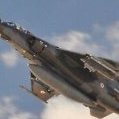
Jetmads has Announced an F-22A Raptor in 1/32 Scale
Violator1991 and one other reacted to mattcour for a topic
I was expecting a modern jet after the X-3 and the FH-1 and my guess was either a Rafale or Gripen but the F-22 is just fine for a jet guy like myself. I love it, great subject. My price guess is around $250. Preorder price of the Viggen was $192 and the F-22 is bigger than that and with the price of everything going up I'd be surprised to see anything less.2 points -
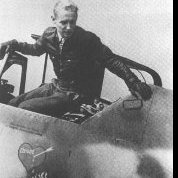
He-111H-6, 1:32, Revell
Sasha As and one other reacted to Hartmann52 for a topic
While I am still at home, I continue to model - soon I will be deprived of this pleasure. While busy with the shooters compartment - again, in addition, the Eduard and Profimodeler kits were used2 points -
Did not get a chance to get super close to it when we saw it at EAA AV when last we were there but two things stood out: 1. - It was the LOUDEST @#$%ing thing I have ever heard since I was a little kid and saw the Concorde at Oshkosh back in the 80s. 2. - It was H U G E. It was in a heritage flight with a P-47, an F-86 and a P-51 and it utterly dwarfed them all. This model is going to be very big.2 points
-
F11F vacuform Blue Angels
GROWLER 96 and one other reacted to daveculp for a topic
Wings attached using a brass semi-spar. Seems strong enough. Next step is printing up some wing fences and flap hinges. Weight is at 202 grams (without cockpit, canopy, landing gear, exhaust).2 points -
Note to self: Add the handlever for cooling water control (direct translation from German) to the driver's side transmission mount bracket. Jose added it but I've overlooked it (until now).2 points
-

EA-6B Prowler (02 April: Done!)
Greg W and one other reacted to easixpedro for a topic
Back at the old girl. Was waiting for the intake paint to dry on the Crusader and jumped back in. Needed to sort the nose gear. After a couple of failed efforts making my own, I came to the conclusion that I needed to use the metal kit bits. To save some weight, I carefully drilled out the center. Worked better than I'd hoped, and allowed me to use some aluminum tube for the oleo section. I'm glad I used it to be truthful. As I started adding parts, I was impressed more and more. It's a work of art. Trumpeter nailed it. I was having flashbacks to doing preflights and checking all the bits. It's literally all there. Love the tow link. That thing is hefty. Used to have on that was a great doorstop, but it disappeared during on of the many moves. Trumpeter even has the spring contraption that holds the holdback. Look at the little spring at the bottom of the gear on the backside. At the base of the spring is a little receptacle that some poor kid put the holdback in. Its shaped like a barbell and snaps at a predetermined weight when the catapult fires. Literally the only thing holding the jet to the catapult. Pretty impressive, especially when you consider a fighter in max afterburner waiting for the cat shot. On a side note, here's one that was given to me after my first cat shot in the fleet. One part stays with the jet till landing, before its tossed and the part that stays on deck usually is tossed over the side immediately. There was a chief in my first squadron that was from my hometown, so he orchestrated the effort to save both. It almost never happens, so pretty cool little momento. -Peter2 points -
Talk about coincidence, I'm getting ready to review this very same book right now.2 points
-
1/32 Trumpeter Harrier GR.5 conversion - Snow Harrier
Piero and one other reacted to crobinsonh for a topic
Superb build as usual. Would love to see all of your 1/32nd Harriers together in a photo shoot.2 points -

RA-5C Vigilante - scratchprinted
sandokan and one other reacted to Starfighter for a topic
I'm glad you guys like it! I've been doing some wannabe-engineering to add stability, ease assembly and to improve fit. Adding surface detail is extremely tedious work but it adds life to the model. You may call me a rivet counter, but I am actually counting them - and I often then create adifferent number of rivets on the model. In my opinion, it is more important to capture the look of the surface detail instead of offering a correct number of rivets. Keep in mind, all the surface detail is not really to scale - like I said, it has to "look" right.2 points -

RA-5C Vigilante - scratchprinted
BiggTim and one other reacted to Starfighter for a topic
Thank you guys! Motivation is still high and asalready mentioned, my wife's urgent desire to rebuild the living room limits my "real" bench time. The cockpit is slowly taking shape: The tail fairing wqas modified again and is now more correct shape wise and a solid part. The tailcone will be a separate part. Wings and LERX have been added. The big LERX gives it away as a late Vigilante. As you can see, I have also started adding surface detail to the rear fuselage section. Tonight, I will run another test print of the forward fuselage with the revised surface detail. Stay tuned!2 points -
oh wait. more of a Stern's plane here:2 points
-
Some relevant content for a change The closest I could get to the Kagero drawing is this, Wr.Number 13803 (G2) , 8./JG 54 , 27.11.1942 source2 points
-
1/32 Hasegawa P-47D 25 “The Virgin”
AlbertD reacted to Tolga ULGUR for a topic
Yet another tick to my 1/32 P-47 to do list. This is 1/32 Hasegawa P-47D25 with the markings of “The Virgin 42-26643” from 510 FS 405 FG. Note that this D25 has Curtiss Electric symmetrical propeller. Cockpit was modified by using Aires cockpit set and Yahu instrument panel. Corrugated cockpit floor borrowed from MDC set. And Eduard seat belts added. I kept Hasegawa’s engine cylinders parts. But I replaced front engine area with Quickboost resin part and the magnetos from Trumpeter spare parts. I have used Quickboost gun barrels and Barracudacast wheels. Painting was done with Gunze Sangyo acrylics. Customized decals are from Custom Hobby decals ( https://customhobbydecals.com/) Happy modelling1 point -
1 point
-
well done, I would have just quietly slid it over to the shelf of doom and started a new kit1 point
-
I hear you loud and clear. It is putting a project one has put his heart and soul in, and subjected it to risks one had not intended to subject it to. But you know, the decision to try skinning this thing was kind of easy. I had three choices - one was to do nothing, two was to fill in with putty and rescribe, and three was to skin it. Doing nothing, I got a strong impression, would have disappointed a whole lot of folks watching this build. And frankly it would have disappointed me too. But so far on my 1/18 projects I have left the surfaces pretty much well enough alone. And consequently the surfaces and paint jobs are the low points of all those projects. To fill in the trenches and pock marks, and do over, I know from experience, is something I am exceptionally bad at. I have tried it on several occasions with icky results. Some modelers here are wizards at it; I am not. So that was a no-go. Then Peter began needling me about skinning ("ah come on - you can do it, go for it...."). He is a master at it as you know. So I looked at some of his tutorials, received more advise through e-mails, bought a mule to practice on, got some material and tools, practiced, and from there it became pretty clear what to do. I had to accept however that this already marathon length project was just going to get longer. Yikes. I am not out of the woods. Not by any means. This has forced my hand and now I am faced with doing fillet fairings, and other compound curvature panels. For instance, what the heck am I going to do with the Corsair's narrow little tail cone??? Almost all other fighters have full length rudders and no tail cone. Not the Corsair... And what I worry about also is the center wing, which I finished prior to making this decision. It would have been a whole lot easier to skin those wing panels prior to gear door and gear strut installations! The flaps too - would be sooo much easier if they were not there. So I am not sure yet to what extent I am going to skin the center wing. Thanks for the kind comments Bill.1 point
-

Jetmads has Announced an F-22A Raptor in 1/32 Scale
KiwiZac reacted to thierry laurent for a topic
Happy for the Raptor lovers.1 point -
Fantastic progress, Paolo!1 point
-
Most updates on Cybermodelers present the most current known updates on kit releases, but it is indeed confusing to "not" see the previous indicated kits to be released. But this phenomena has occured often on Cybermodelers' update list, one day you might have a update list, and the other day it all (apparently) changed as if the previous have been cancelled and not being released, but in the end they will.......1 point
-

RA-5C Vigilante - scratchprinted
dodgem37 reacted to Starfighter for a topic
Another test print. 0,2mm is a good width for groove lines in 1/32nd scale and I am pretty sure my printer wouldn't be hable to handle thinner details anyway. Cockpit looks quite good; fit is very tight and the parts need some adjustment, but keep in mind that thing was designed by a total moron (=me) sitting on his couch or during ht ebreak at work... I am rather happy with the look so far. The intake design works as desired as well. I will now add more details to the cockpit and add all the surface detail before printing the next parts.1 point

